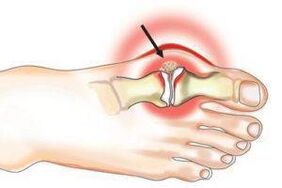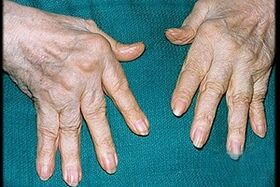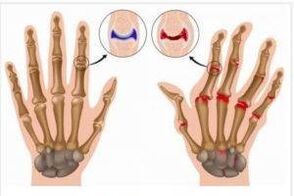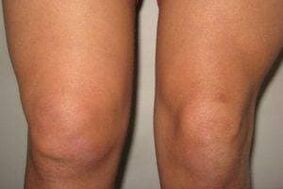Many people do not always understand the difference between arthritis and arthrosis because of the similarity of names.Both diseases are related to the joints, but the causes, symptoms, diagnosis and therefore treatment are radically different.It is very important to determine the nature of the disease at the initial stage in order to initiate proper treatment.
Arthritis, arthrosis and their effect on the joints
To begin proper treatment of the joint, you must first determine what kind of disease is susceptible.And to do this, you need to find out for yourself the difference between arthritis and arthrosis.
Both diseases affect the joints but have different symptoms and causes.
What is arthrosis

Arthrosis sooner or later affects about 10% of the population, most often manifests with age.Arthrosis is a deformity of the joints and a decrease in their mobility.His correct name should be considered osteoarthritis.
The main symptoms are pain in movement and loss of mobility, the range of movement in the affected joint decreases, and when movement, unpleasant, dry and acute crispy occurs.Deformation can also be observed in osteoarthritis.For example, it is very easy to notice a change in the shape of the knee joint.
Osteoarthritis can be detected at the initial stage.The diagnosis is complicated only by the careless treatment of the patients themselves.Pain in the initial stage occurs only at load, so many do not attach importance to it, which worsens the disease and complicates the treatment.
Arthritis and its symptoms

While arthrosis is a disease only of the joints, arthritis is often infected and affects the whole body.Such diseases are one of the manifestations of the general condition of the body.It is much more difficult to treat and to diagnose.Joint pain is accompanied by swelling and inflammation;The pain does not disappear, but only intensifies, much faster than with arthrosis.Infectious arthritis not only affects cartilage tissue, but has a negative effect on the heart, kidneys and liver.Although arthritis is approximately 5 times more common than arthrosis, it is much more difficult to cure, they are a great danger to the patient's life and the causes can be diverse.
The main symptoms of arthritis are:
- high temperature;
- inflammation of the skin, psoriasis;
- General weakness of the body;
- eye discomfort;
- ejection from the genitals;
- Chills, increased sweating.
The skin around the joints is particularly hot and swollen.
How is arthrosis arthritis different in the nature of the disease?

To better understand the causes of such diseases, you need to understand their nature and classify them.
All joint diseases can be divided into two groups - inflammatory processes and dystrophic.
In order to determine the nature of the disease, the symptoms of which are similar to another, it is important to diagnose and determine the cause of a particular process in the body.
The main problem with both diseases is the imbalance in the joints between the processes of destruction and repair.The stronger the imbalance, the more the bone tissue is destroyed, which manifests itself at the cellular level in a lack of oxygen and nutrition for them and poor production of healthy bone components.
Most often, the process goes unnoticed and when the number of dead cells exceeds the norm, pain occurs.In this way, the body tries to "mourn" excessive stress and ask for help.
Dystrophic diseases
Most often, such diseases have characteristic names that have the same endings: arthrosis, osteochondrosis, ligamentosis, osteoarthrosis.Such diseases occur with age or with constant physical activity.Footballers, for example, often suffer from knee osteoarthritis even at a young age.Most athletes are susceptible to knee disease.
The joints show painful symptoms due to the thinning of the cartilage tissue called degeneration.Such diseases develop due to the general aging of the body, a sedentary lifestyle and the infectious nature of diseases that can accompany the development of osteoarthritis, osteochondrosis and similar diseases, only accelerate the process of degeneration.The body has no time to replace dead cells, that is, regenerates and the reverse process takes place.The most difficult to stop is the tissue degeneration of the knee joint, which is so widespread.
Inflammation

Such diseases also have similar endings and often end in —it.Often infectious by nature, bacteria or viruses can cause inflammation of one or more joints that will have the appropriate symptoms:
- fever;
- swelling;
- sweating
They can also be autoimmune or allergic infectious in nature when the body fights its own cells.In this case, the pain and swelling of the knee joint can show serious problems with the immune system.In the case of knee pain or any joint, you should consult a doctor immediately for a complete diagnosis of the body.
Often the cause of joint pain may be the deposition of salt in the cavities and periarticular tissues.In this case, there is a possibility of metabolic disorders.
Osteoarthritis and arthritis - treatment
As the causes of the diseases are completely different (with osteoarthritis, the joint is worn mechanically and arthritis is infectious), the treatment will be completely different.That is why it is so important to divide these two diseases.
Let's look at the treatment using the example of the knee joint.In both cases, it is necessary to reduce the load as much as possible.The arthrosis of the knee joint or another joint cannot be cured as the process is irreversible.However, regular use of chondroprotectors can slow down the process, stimulate cartilage regeneration, and reduce pain in the knee joint.
Infectious arthritis can be treated with antibiotics and drugs that affect the immune system.In some cases, the course of treatment will need to be repeated, but the disease itself is completely treatable.
If the diagnosis shows rheumatoid arthritis, then you will have to be treated for a very long time with small doses of cytostatics and corticosteroids.All this is used in combination with anti -inflammatory drugs.Modern treatment makes it possible to achieve long -term remission and reduce the use of hormonal drugs to a minimum.





































